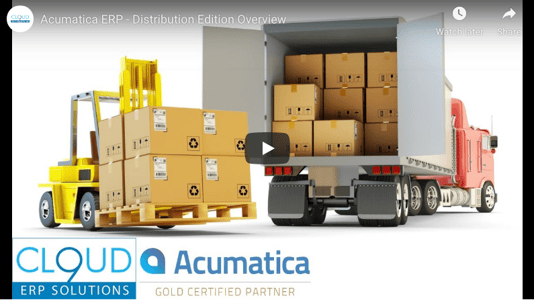Pivoting Toward Recovery: Combining Inventory Optimization and AP

Today’s distribution firms have spent the year facing immense challenges just to keep the lights on. An unexpected revenue drop, staffing challenges, and international supply chain disruption have all come as a result of recent lockdowns, and the path to recovery might still look slower than one may hope. But recovery is coming, and it’s going to be important to keep your business focused on whatever is next.
2020 Might End with a Whimper—But 2021 Presents an Opportunity for Rebound
According to MDM, the fourth quarter has gotten off to a rocky start, continuing the slide that started around March. With expectations that we close 2020 out with a 10 to 12 percent slide as opposed to 2019, we’re all looking to put this year behind us. But 2021 is right around the corner, and MDM is looking at a reasonably productive year.
“Distribution should return to modest growth in 2021 (2.6%) and strong growth in 2022 (9.5%), but the recovery will be a slow climb and industrywide sales growth won’t return until the second quarter of 2021.”
But no matter how it shakes out, those are industry numbers—and are focused on revenues. The real question to ask, what’s next for your company and how can you continue to focus on building margins, keeping cash flow stable, and putting yourself in a place that allows you to thrive? It all starts with looking at what you have and discussing opportunities to improve.
From shoring up and optimizing inventory to increasing payment visibility for better cash flow, here are just some of the ways that the right system and right partner can put you in a position for improvement.
Connecting the Dots: Inventory Optimization
Whether you weathered the storm of 2020 and are focused on growth or you need 2021 to be the year that keeps you afloat, the right focus, tools, and partner can put you where you need to be. At Cloud 9 ERP Solutions, we’ve worked with distribution firms across the Northeast to deliver business management products configured for success, helping these firms take control of money, product, and more.
The past two decades have presented businesses with new approaches and goals. Once considered simply an asset that just required tracking and a balance between supply and demand, companies began to look at ways to get more from it.
The Rise of Inventory Optimization
Inventory optimization, something considered a “theoretical construct relegated to classroom instruction” in the early 2000s, started to become a reality at the turn of the last decade.
Defined as the process of scientifically determining the right inventory levels across the supply chain, companies saw value as they began to rethink processes. Inventory levels were lowered, fill rates became a priority, and the companies who did it right saw an increase in customer satisfaction.
Keeping Up with the Competition
But throughout the 2010s, the science was refined and the technology to manage inventory evolved. Many companies reduced inventory—but ultimately failed to optimize. Disconnected processes led to blind spots, disjointed workflows led to delays, and those who didn’t continue refining failed to recognize the benefits. In fact, this might have even hurt companies.
Too often, companies would focus on one area of inventory optimization, only to forget that they lost the plot in other areas. For some, poor planning led to poor fill rates. For others, poor warehouse management led to inaccuracy and delays.
Mind the Gap: Going beyond Single Focuses
According to Deloitte, too many companies look at inventory management as a “black box,” hoping that their investment in planning systems will address all of these foundational ingredients. They may be able to answer questions like “How much do we need?” and “Where should we put it?”, but fail to move beyond this.
But to succeed in tomorrow’s business, the real questions you need to answer are “What went wrong with the plan?,” “What is excess and what is inefficient?”, and most importantly “How can we improve?” Paired with the next goal, it’s pivotal to dig deep and know how everything works.
Moving Forward: Cash Flow and Payment Focus
If inventory optimization is the first step, being able to parlay this into value and growth is the next. By starting with the integration, intelligence, and configuration needs, you can turn this into value in a variety of ways.
Understanding Your Payables
One of the most likely situations that presented itself to you in the past few months? You might have been short on cash. You have to get paid to pay your vendors, so when your revenue stream dried up, your vendors probably came calling. Last month, we explored key strategies to rebuild and reinvigorate your relationships with supply partners, discussing your path to closing the tab and putting your company on the road to working more closely with them.
But the ability to get back on a supplier’s good side is one part—freeing up cash flow is the other. Considered one of the key metrics on the road to recovery, distribution companies need to look at a metric called Days Payables Outstanding.
DPO, a measure that reflects the average number of days that it takes an organization to pay its creditors, is a metric that directly linked to cash management and liquidity. Organizations need to be able to track and adjust their DPO to improve their cash flow and working capital while protecting their balance sheet profile.
As noted in a discussion on this metric, companies need to balance a strategy focused on shortening the window, looking to capture discounts and save money, with one focused on extending it.
Tracking and Optimizing Payables Requires a Deeper Understanding
But more often than not, companies are looking at their accounts payable and often missing the point. Without visibility into how things are moving, you’re not going to be able to optimize this and other key performance indicators.
Integration, Intelligence, and Configuration Address the Gaps
ERP is going to answer some of the basics, but especially with legacy products, you’re still leaving other questions unanswered. In the road to a better 2021, you’re going to need to become more flexible. The outbreak and lockdowns threw a wrench into simple forecasting and inventory.
Inventory models need to evolve and cash flow needs to be understood, incorporating more data from more places. In this, companies need a partner like Cloud 9 ERP solutions and a modern solution that can deliver.
Integration: The ability to build complex models requires you to handle more data sources. In turn, data will need to flow from one product to the next. Distributors need a product that is going to connect necessary tools, and to get that are looking for solutions built to integrate easily. Learn more about this in our article on APIs in the distribution industry.
Intelligence: Understanding the complexities of the inventory optimization process requires a tool that’s powerful enough to handle the data. If integration helps data move seamlessly, intelligence helps you understand what the data is trying to say. From dashboards to business intelligence, reports should help you move closer to your goals. Get to know more about BI.
Configured to You: Even the right solution in the wrong hands is going to leave you with blind spots. Products need to work for your people and your business goals, and the right partner will know what this means and how to deliver it. That’s where Cloud 9 steps in. Learn more about how we made this happen for a Caswell here.
Cloud 9 ERP Solutions: Delivering Expertise for the Distribution Industry
When it comes to looking at business management solutions for your distribution firm, the right product can make all the difference—but only if you can find the right partner to get you there. As a Gold Certified Acumatica Partner, we have configured and implemented this cloud ERP solution for distribution firms like yours and have worked hard to understand the nuances that affect your industry.
Get to know more about how we deliver for distribution firms here, or view our Acumatica Distribution Demo.
Additional Distribution Resources
Are You Using a Modern Distribution Management Solution?
Visibility Key for Wholesale and Distribution
Why Anytime, Anywhere Access Matters for Distribution Firms




